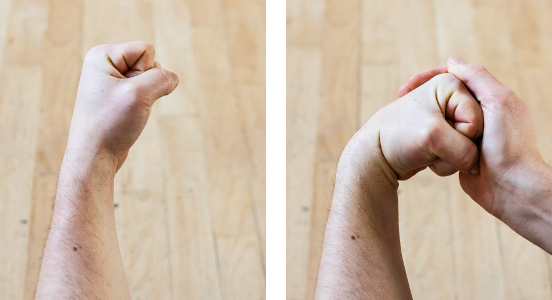So many people I know suffer from some sort of ailment stemming from repetitive movement or position coming from their occupation. Seeing how “office job” is a big category of occupations, I put together this list of short exercises for people who work at a desk to take care of their bodies.
Wrist self-massage
Roll the skin
Gently grasp a fold of skin on your wrist with your thumb and fingers, then roll that out like shown below. This will separate the layers of tissue, and loosen the whole wrist. Be warned that it can feel like a quite strong burn, so start gently.
Roll the thumb and pinky pads outwards
Similarly, gently grasp the fleshy pads either side of your hand, and roll them out. This contributes to unloading the famous carpal tunnel by loosening the tissue around it.
Carpal tunnel opening
Obviously we’re not literally opening the tunnel, but we can slide the tissue surrounding it in ways that should relieve some pressure off it. Place your fingers on the back of your hand and your thumb on the centre of your wrist. From there, firmly “brush apart” the tissue over the base of your hands: you’ll feel the bones just after the creases in the skin; rub them with an outwards motion.
Here is a slightly modified version of this self-treatment in video:
Wrist stretches
Wrist flexors
Put your palms together roughly in front of your face, while keeping your elbows dropped. Then lower your hands and let your elbows flare out until you feel a stretch in your wrists. Keep that for a few seconds, and repeat one or two times.
Wrist extensors
Put the back of your hands together, roughly in front of your stomach, allowing your elbows to flare out as much as they want. Then bring your hands up and drop your elbows, until you feel a stretch on the back of your wrists. Keep that for a few seconds, and repeat one or two times.
Typing stretch
I call this the typing stretch because it targets both wrist and finger extensors, which take a beating when you type for long periods of time.
Form a light fist with one hand, and grasp is gently with the other hand. Now bring your wrist into flexion while keeping the fist. Use your assisting hand to keep the shape of the fist so that you can stay completely relaxed in your stretching hand. Keep the stretch in the back of the wrist for a few seconds, and repeat one or two times.
Neck and shoulders self-massage
Cat mama
Drop your head forward, then gently grasp the back of your neck without using your thumb. Squeeze as you tilt your head backwards (kind of grabbing yourself by the scruff of the neck), and relax as you bring it forwards. Repeat a few times.
Note that it’s also great in reverse: firmly grasp the back of your neck with your head upright, and drop your head forward, technically pulling the skin of the back of your neck with the weight of your head.
Upper traps sponge
Grasp your upper traps without using your thumb. Squeeze as you lift your shoulder, and relax as you bring it back. Repeat a few times.
You can add an image to that: imagine that your upper traps is a sponge, full of dirty water (say you’re in the middle of washing up). Now as you lift your shoulder and squeeze, imagine you’re squeezing this water out of the sponge, and as you relax your grasp and release your shoulder down, the sponge fills with fresh, clean water again. This will make this technique vastly more effective!
If you like these two exercises and want more, check my Ultimate Neck Self-Massage guide.
Various advice
Drink plenty of water
Dehydration can cause headaches, and will lower both your mood and your productivity. Keep a glass at your desk and make sure it’s never empty.
Move around!
Get up, go up and down stairs, walk around the block… At a more reasonable scale, you can help this by organising the office in a less efficient way, so that you often have to get up. Similarly, resist the urge to outsource your movement: if you need something at the other end of the office, go get it yourself.
Adjust your screen luminosity.
A difference between the luminosity of your screen and that of your surroundings can also cause headaches, or unnecessary fatigue. Make sure your screen is dim enough that it doesn’t stand out of your office, luminosity-wise. In doubt, keep is on lower luminosity.
Look outside at distant objects, regularly.
Looking at close objects make the muscles around your eyes contract to adjust to this proximity. If these muscles don’t get released from time to time, they will just compress you eyeball and create nasty headaches. Look outside of your window to the clouds or the furthest buildings you can see. If you don’t have a window, look at the furthest corner of the room, maybe pop your head into the coridor…
Vary your positions.
Having a good sitting posture is great, but what is most damaging is immobility. Vary how you sit so that a greater amount of tissues get loaded in a bigger variety of ways. Sit “normally”, sit cross-legged on your chair, cross one leg on top of the other, cross the other leg, kneel on your chair… There are many, many ways to use a chair.
Continue reading: Office and Workspace Health, The Ultimate Neck Self-Massage, Sitting Posture.
This article also exists in French.
Want more like this?
Check out the following blogs from massage therapists I know from around London:- On The Run Health and Fitness on running, nutrition and sports massage.
- The Soma Room on sports massage and exercise.













No Responses